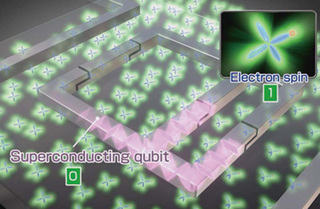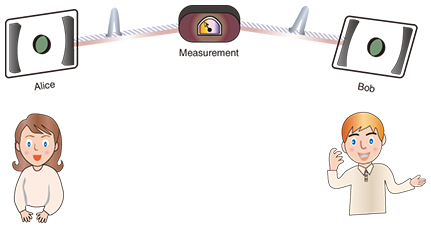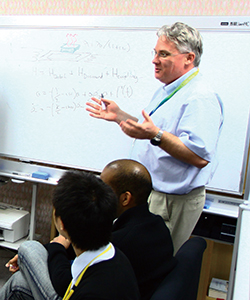Overthrowing established theory and envisioning quantum networks of the future
—Dr. Munro, please tell us about your current research.
Well, I am researching the creation of new quantum technology through the exploration of the unique properties of quantum physics and the fundamental limits it has on information processing. For example, my pen consists of a variety of small parts (the case, spring, etc.,…). Each of these parts is made of smaller parts, some too small for the human eye to see (micron sized for instance). If we go even smaller, by factors of one thousand or more, we would eventually arrive at atoms, the building blocks of matter and nature.
What is of importance here are that the laws that govern the pen as a whole and the laws describing the atoms can be different. Classical mechanics governs our real macroscopic world while “quantum mechanics” is generally thought of as the laws that govern the atomic world. Throwing the pen at a wall, we all know it will bounce off, but throwing the atom can produce a really interesting result. It can tunnel through it but will never be found in the wall. This is one of the interesting effects quantum physics allows.
Technical innovation in electronic devices has become so familiar to us in our daily lives due to the miniaturization trend. Our automobiles we drive every day now contain many small computers that control many of its basic functions. The car is probably classical in nature, but it may have had quantum physics help in designing it. These quantum principles are used for instance in the construction of
the microprocessors that make up the computers.
By embracing these quantum properties, we can bring about a true technological revolution. In short, it can make possible new things that could not be achieved in the past (or even thought of), such as building absolute secure networks on a global scale or next generation computers. Quantum computers (Fig. 1), which are currently attracting significant worldwide attention, could be billions of times more powerful than the computers we are using today or could exhibit a level of performance greater than all computers in the world combined. Quantum computers could in principle process more data than the total number of atoms in our Universe!!!

Fig. 1. Schematic of a super-conducting qubit. This is a key element for the quantum computer.
The quantum world is quite unique by the standards of classical physics. Quantum entanglement suggests, for instance, a phenomenon in which multiple quanta situated far apart from each other nevertheless are inextricably correlated is possible, much like the two sides of a coin. It is hard to believe, but this phenomenon exceeds time and space. The question is, how do we realize devices that exploit this, and how do we make quantum principles useful in our everyday lives? The phenomenon of quantum entanglement is turning into an indispensable resource for quantum communications, computing, and metrology. A focus of our group and other researchers in this field is to create technology roadmaps extending 20 to 30 years into the future on quantum information processing (QIP) systems using these quantum principles and to discover how to bring about great changes in the world through quantum technology.

—Can you tell us something about global research trends in this field?
The birth of quantum computers and quantum information enabled devices that will give rise to entirely new industries. For example, e-commerce in the conventional sense could cease to exist as its security is removed or may need to be completely reegineered. While this may seem a little negative for society, there could be some big gains as well. We will be able to achieve things that we can just not imagine now. In the field of medical care, it could become possible to design drugs tailor-made to the individual patient and their condition, or in the field of meteorology, the quantum computer could enable accurate weather predictions many weeks in advance. That would have an enormous impact on the harvesting of crops. This is our vision that some may treat as just a dream, but it will become a reality in the not too distant future.
In the field of information and communications, data security is becoming a major issue of concern around the world. To achieve a major breakthrough in this field, we need to change the rules. Today an encrypted message is unlikely to be opened unless one possesses the key for decrypting it or actively cracks it. However, quantum communications will make it possible to send messages with absolute security. If the sender and receiver of a message possess a random bit sequence called a “secret key” that cannot be predicted by anyone (other than the sender and receiver), and if that key is destroyed after use, then confidential communications can be carried out along a wireless communications path or a public communications path such as the Internet (Vernam cipher).
The questions is how to get this key. Quantum cryptography is a method of providing the sender and receiver with such a secret key by having them exchange the quantum mechanical superposition states between them. This process is called quantum key distribution (QKD). To give an example, let’s assume QKD apparatus operating over a distance of about 100 km (Fig. 2). The sender and receiver (Alice and Bob) can obtain a desirable secret key in this way. Here, Alice sends photons prepared in a few known states over a fiber to Bob who measures them in a random basis. When the basis of Alice send photons and Bob measured photon agree, they keep the resulting bits. Next, they correct for bit errors, and finally, they shorten the bit sequence to an appropriate length based on the level of information that can be leaked to eavesdroppers (nature or Eve).

Fig. 2. Principal of QKD.
By the way, I am proud to say that our group is at the forefront of quantum communications research, especially in QKD and quantum networks. Research in this area spans a period of nearly 15 years. In the beginning, communication rates were limited to about one quantum bit of information per hour. However, we are now proposing schemes for transmitting millions per second, which was initially doubted by the research community but is now widely accepted and admired.
—What made you think of NTT as a place to pursue your research?
The wonderful research environment! I have experienced research life in universities and companies overseas, but at NTT, I feel that I am quite fortunate to be in an environment in which theoretical researchers can interact smoothly with lots of experimental groups. Overseas, it is typical to have one experimentalist to ten theorists, but at NTT Basic Research Laboratories, the ratio is just the opposite: 10 experimentalist to one theorist (maybe even 20 to 1). When I get an unusual idea in my head, I can talk to my experimental colleagues and say “Is this a crazy idea or what?” I may quickly be told “It may not be so crazy. Maybe we should build it!” It is truly a unique and wonderful thing to have colleagues like this who can respond quickly to our ideas. The opposite is of course also true, we help them understand many of their experiments.
Our group is extremely interactive in its approach to research. Whenever a member of our group comes up with an interesting idea, we actively discuss it using the language of mathematics, and we might spontaneously start to write equations all over the board. Of course, these equations could be replaced by conventional words, but it might take about 50 pages of text in either Japanese or English to communicate what these equations are saying in a few lines.
In these last few years, leading overseas companies such as HP and IBM have been downsizing their research laboratories, but at NTT, the value of research and development continues to be appreciated, and basic research is still being given the importance it deserves.
On the other hand, in terms of job duties, rules, and discipline, the research laboratories when I entered NTT were like a typical Japanese company. So I talked about this with management, telling them that I wanted to place priority on results, and they allowed me to pursue my research in an open and transparent environment with a flexible work system. I believe that a researcher cannot be creative if stuck at a desk thinking only about what he or she should be doing.
Engaging with your colleagues in a Polo-shirt and half-pants—it’s results that are important!
—Are you saying that, in the sense of research technique and researcher behavior, a flexible approach is necessary?
Let me give you a typical day in our group as an example. The members of our group do not lead the life of a typical business person. I myself get to work by 7:00 a.m. and leave by 4:30 p.m. What is important for a researcher is not to work long hours but to be productive. I rarely wear a suit at work, and for most of the year I pursue my research activities in a polo-shirt and half-pants. The attitude toward research has also changed over time. Up to 20 years ago, it was thought that research was a task carried out by an individual researcher, but in recent years, this has changed to research achieved through teamwork. This can be understood by looking at recent NTT research papers that generally present the results of small teams of researchers all working in concert. Everyone in the team has their part to play! In fact, you are likely to be in several different teams.
When a Japanese researcher wants to get another opinion from someone, I think it’s common for them to go to a meeting room with that colleague and have a long discussion just between themselves. However, I think a work environment conducive to dynamic and energetic discussions that can attract and involve other people in the area is essential to stimulating new ways of thinking.
Whether what you say in such discussions is right or wrong is not the issue. Making your point clearly without hesitation makes it possible to fine-tune the topic being discussed. My group and related laboratories are actually building such relationships. For me, such an environment and relationship is natural and matter-of-course. Japanese companies, however, tend to be caught up in vertical relationships, and a common scenario is to give the right to talk to senior staff first and to expect others to follow. In NTT laboratories, as well, there is a hierarchy as reflected by our titles (mine seems to have the word “senior” attached). However, if we strip this away, we are all just “researchers,” and who talks depends on the situation. I hope many NTT researchers know that an open environment exists, and if they come across their colleagues engaged in a lively discussion, dive right in and join the discussion! (Photo 1)

Photo 1. �Promoting active discussions.
—To maintain flexibility and creativeness in thought, what do you do in your private life?
When I want to relax, I cook, which is an activity that gives me much pleasure. In this regard, I’d like to mention that, in addition to being a physicist, I am really a chemist. In the sense of mixing together a variety of materials, cooking and chemistry have much in common. Even while I’m cooking, I will have my computer open with a divided screen so that I can enjoy, say, a rugby match on one window while checking out a recipe for a chocolate cake on the other. This enables me to receive two sets of stimuli at the same time. Actually, ideas come to me quite frequently in this way. In addition, having my computer always open enables me to write down any ideas that pop into my head at that time. Of course, writing down such a random sequence of ideas hardly results in clear and concise text, but I have fun putting them all together later, like pieces of a puzzle. Ideas don’t come easy to me when I’m tired, so I also enjoy walking and cycling. I walk to and from work every day, and on weekends, I may walk as far as the Imperial Palace (20 km). I also enjoy my e-book collection of over 1000 works, and I like reading, in particular, science fiction and manga. I think that the world described by Arthur C. Clarke in his books has actually become a reality in many respects. The world of the Japanese manga Dragon Ball Z, on the other hand, is fantasy, but I enjoy it because it’s different. Its unorthodox ideas are “outside the box,” much like day-to-day research.
Envisioning the future through a dynamic and flexible approach unrestrained by existing concepts
—Dr. Munro, what advice would you give to young researchers?
All in all, please think outside the box. Your idea may be crazy, it might seem ridiculous to other people, but out of 100 ideas, one may still be a very good idea. Pursue themes that can have a great impact on society, that can change the world. And in doing so, don’t be afraid of failure. In fact, failing in solving problems is not a failure. Use it as an opportunity for thinking how you can do it better in the next step of your research. If you can’t fail, you can’t succeed. Actually, when a young researcher or postdoc comes to my office for consultation, I begin by throwing up about 100 different ideas in the air. We will sit in front of a whiteboard and talk nonstop about the feasibility of a certain idea, what might be attractive about it, and while it may not be achievable soon, how best to approach it. Research, in a word, is a passion. Without your own ideas, you are just doing standard work with little job satisfaction. A researcher has an objective in his or her research, such as “I want to solve something” or “I want to explore something.” So without passion, it’s hard to continue and accomplish something significant. Finally, I would like to emphasize the importance of communication. Actually, this holds true for all researchers, not just young staff. Don’t think that you can do it all on your own at your desk—please talk to the people around you and ask questions. Your neighbor may be able to solve a problem that you have been stuck on in just five minutes. If you sometimes get away from your desk and research laboratory, it’s easy to receive stimuli from the outside!

—Finally, what are your plans for the future?
It’s very simple: realize these quantum devices! Actually, quantum mechanics itself is already being incorporated in high-tech devices. Our challenge is to make such devices that are actually using quantum principles even more powerful. This attempt of ours, however, is not simply an extension of ongoing technology development to make computers or communication devices smaller. Our goal, rather, is to do something radically new while using the same principles. In this way, we want to bring about not just change but a real revolution. To be more specific, we are working jointly with various experimental groups with the aim of creating a compact quantum device within the next five to ten years. We are still at the basic research stage, and talk on how such a device would actually function is still a bit further away, but we are steadily advancing.
As for myself, I enjoy my daily work immensely. In fact, I don’t think of research as “work” but rather as something that I take extreme pleasure in doing. What is difficult is separating the pleasure of research from work. We are at the forefront in this field, and our role as researchers is to push the boundaries to fundamentally change society for the good. Research isn’t evolution, it’s revolution!

